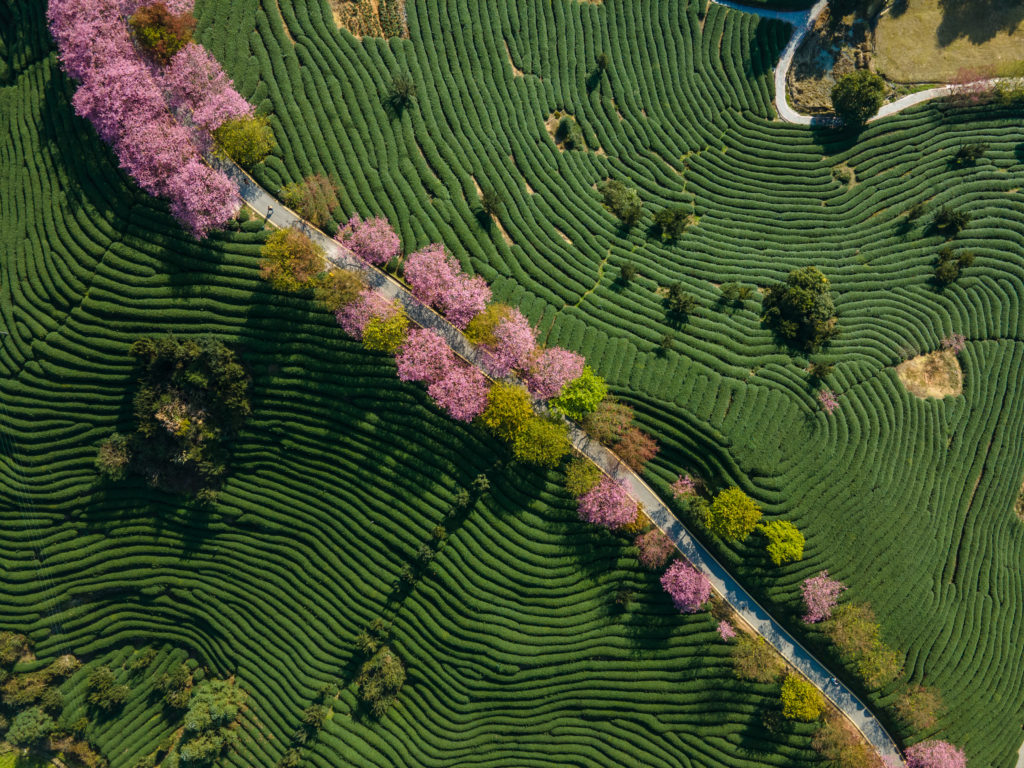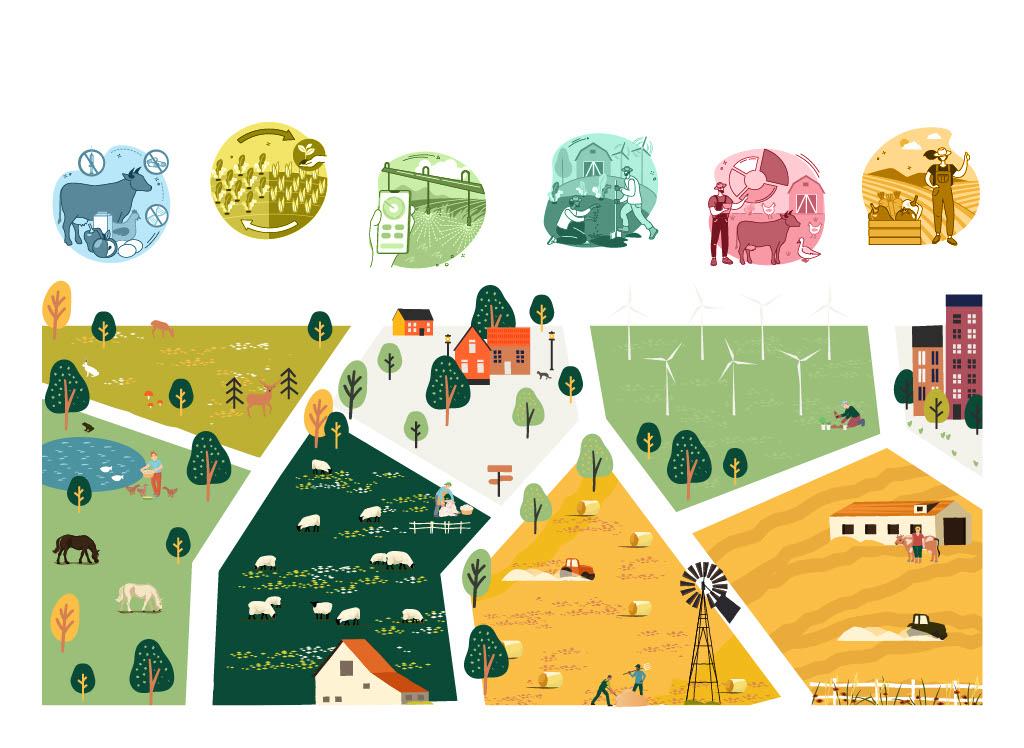Case study
Beyond the farm gate: Monitoring regenerative agriculture at landscape scale
Regenerative agriculture is no longer just a buzzword—it is a global movement inspiring farmers, companies, investors, and policymakers to reimagine the future of food and land use. But as the world rallies behind ambitious commitments to regeneration, one critical question remains: How do we measure success? Are individual efforts truly adding up to the transformative change we need, or are we missing the bigger picture?

Much of today’s monitoring takes place at the farm level, focusing on practices and indicators like fertilizer use, crop rotations, and tillage. These are valuable, but they only capture part of the story. Regenerative agriculture is not confined to individual farms but is part of a larger system. Its outcomes—whether in soil, water, biodiversity, community well-being, or governance—emerge over time from the interplay between farms and the wider landscape. To fully understand this interplay, we need a robust framework to assess how farm-level outcomes are embedded within the wider landscape context—and how landscape dynamics influence the transformation toward regenerative agriculture.
Understanding the farm–landscape connection
While a growing number of initiatives have started defining what regenerative agriculture should achieve, very few have translated those visions into applied, practical methodologies for measuring progress across entire landscapes. Without such an approach, a regenerative transition will be held back. We risk overlooking how the enabling or disabling conditions of a landscape—such as ecosystem connectivity, institutional support and incentive structures, or workers’ rights—influence farmers’ willingness and capacity to adopt regenerative practices that deliver lasting benefits for people, nature, and climate. A landscape lens also reveals how farm-level decisions ripple outward, shaping ecological corridors, watershed health, local livelihoods, and the resilience of neighbouring farms. By assessing these interactions systematically and across scales, we can illuminate both opportunities and trade-offs, providing decision-makers with the insight needed to allocate resources effectively, foster collaboration, and anticipate unintended consequences.

Imagine a company that depends on crops in one region, for instance. The company aims to protect and sustain its supply over the long term, so it decides to invest in interventions to improve soil quality across a network of farms in its sourcing region. To determine which interventions will be most impactful at scale, the company needs data that goes beyond farm-level soil metrics such as soil organic matter. In this case, the company may need to work with local partners to better understand how soil quality interacts with local water dynamics, how surrounding land use affects farm biodiversity and soil erosion, and how farmer livelihoods are evolving within the landscape. This perspective enables a more systemic approach to assessing and addressing the root causes of sustainability challenges.
Introducing landscape-level regenerative agriculture assessments
LandScale’s new Regenerative Agricultural Assessment Lens (the “Lens”) has been developed to fill this gap. Comprised of a comprehensive set of indicators and corresponding metrics, it provides landscape initiatives and their partners with a practical framework to evaluate regenerative agriculture across entire landscapes.
Applied through LandScale’s established assessment process and validation mechanism, the Lens equips users with credible insights into a landscape’s current state and trajectory. By repeating assessments over time, users can track changes, identify trends, and understand how interventions are shaping the ecological, social, and economic dimensions of production landscapes.

The Lens is built on LandScale’s existing Assessment Framework, which provides initiatives with the structure and resources to organize and implement assessments across four pillars: ecosystems, human well-being, governance, and production. It adapts this holistic foundation to regenerative agriculture, identifying the indicators and metrics most central to the dynamics of regeneration across social, ecological, and economic systems.
So, what sets the Lens apart? Some indicators from the Assessment Framework have been tailored to emphasize regenerative processes, while others have been set aside to sharpen its focus. New indicators—such as soil, agrobiodiversity, and institutional support and incentive structures—have been added to address key gaps. The result is a balanced set of core and additional indicators, paired with essential and complementary metrics, designed specifically for assessing regenerative conditions and outcomes at the landscape scale.
The indicator package that constitutes the Lens was developed in consultation with leading organizations in the field—including the Rainforest Alliance, Regen10, The Nature Conservancy, Field to Market, and Sustainable Food Trust—ensuring it builds on the latest literature and methodologies and aligns with best practice. Above all, it is designed to be applied in real-world landscapes, capturing the underlying complexity of multifaceted areas without overwhelming users.
Working in complementarity to amplify impact
Crucially, the Lens complements other regenerative agriculture initiatives by providing a missing piece: practical, credible monitoring at the landscape scale.
Take Regen10, for example. Its forthcoming updated Outcomes Framework is a valuable guiding compass for the regenerative movement, setting out the ecological, social, and economic outcomes we must collectively work toward at both farm and landscape levels. Co-developed through a global, cross-sectoral collaboration of farmers, businesses, conservation groups, and civil society organizations, it defines a shared set of outcomes that express the results we are collectively striving to achieve, rather than prescribing specific practices or tools.
This outcomes-based focus is essential: it enables alignment across diverse actors while allowing flexibility in how change happens. By linking the indicators assessed through the Lens to these outcomes, LandScale ensures that its measurements are grounded in a credible, cross-sectoral reference for regenerative agriculture. The Lens operationalizes Regen10’s landscape-level outcomes, turning its vision into measurable insights that show how landscapes perform and evolve over time, and demonstrating how progress can compound toward longer-term outcomes.
Additionally, when used alongside farm-level monitoring and certification schemes, such as the Rainforest Alliance Regenerative Agriculture Standard, the Lens adds critical context—helping to explain why certain farm-level outcomes are (or are not) achieved and revealing the enabling conditions that shape adoption. Together, these initiatives form a coherent approach for understanding how farm-level practices are linked to broader social, ecological, and economic dimensions across entire landscapes.
Taking a systemic approach to regenerative agriculture
At its core, the Lens takes a systemic approach—examining interactions and dynamics across the landscape to provide a comprehensive view of its conditions—consistent with the Assessment Framework. The Southern Leyte landscape in the Philippines helps to illustrate how this can take shape: its assessment uncovered how deforestation driven by farmland expansion has reduced soil quality and water retention, creating challenges for local farmers’ productivity and livelihoods (LandScale Case Study, 2025). These farms do not exist in isolation—they are part of interconnected landscapes where ecological processes, governance structures, market forces, and community dynamics converge.
By assessing these systems as a whole, the Lens—coupled with LandScale’s assessment process—helps stakeholders understand not only whether regeneration is happening, but why. It guides efforts to identify where coordinated action can drive the greatest progress, while also uncovering vulnerabilities that require additional support. And because it is grounded in credible, repeatable measurement, it provides a basis for coordination and shared accountability across diverse actors.
This approach is essential for building resilient agricultural production landscapes that can deliver benefits over the long term. Regenerative agriculture is not just about changing practices on farms—it is about creating enabling conditions that allow those practices to take root, grow, and generate widespread outcomes that endure, ultimately resulting in healthier, more vibrant places.

From farm-level action to landscape-level outcomes
The launch of the Regenerative Agriculture Assessment Lens is an important step in advancing the field. It equips diverse stakeholders—from companies and producer groups to NGOs, investors, and governments—with a shared tool that brings them together in partnership to assess, monitor, and ultimately accelerate regenerative agriculture at landscape scale.
The work does not stop here. Like regeneration itself, the Lens will evolve over time, informed by feedback, field application, and continued collaboration with partners. But its purpose is clear: to provide the credibility, rigor, and actionable insights needed to guide efforts to scale beyond the farm level and drive transformation across entire landscapes.
We invite stakeholders across the regenerative agriculture movement to explore the Lens, pilot it in their landscapes, and contribute to its ongoing refinement. Together, we can build the evidence base needed to guide smarter investments, more effective policies, and stronger partnerships—ensuring that the seeds of regenerative agriculture grow into thriving landscapes that benefit people and the planet.